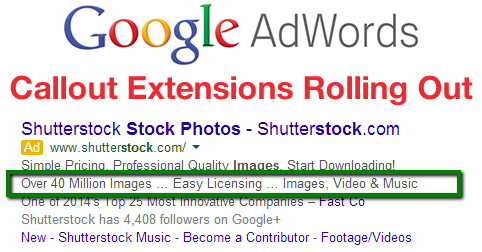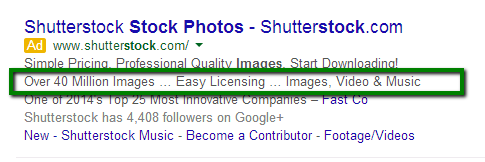Callout extensions are coming out of beta and rolling into all accounts starting this week. This new extension type displays as 3 or 4 extra text snippets typically shown below the ad description body separated by “…”s.
Google’s direction on callout extensions is that they are meant to “callout” the unique selling propositions of a brand or its products. Facts, figures and dimensions (think numeric qualities) are encouraged though not especially enforced.
The Beta
Extensions are an area where Google focuses a tremendous amount of testing. Extensions have proven key to increasing CTR’s, which for Google equates to revenue. The typical threshold for releasing a new extension out of beta is that testing shows it provides at least a 10% lift in CTR across Google’s test.
In late July Google rolled out dynamic sitelinks . This means for accounts where manual sitelinks haven’t been applied, Google will step in a force sitelinks to show and make sure then get that 10% lift in CTR. There were still some gaps though. Since Google no longer allows sitelinks that direct to the same destination url, some sites do not have content to support any (or many) sitelinks. This is particularly true on mobile devices where single-barrel funnels are not uncommon. By allowing these advertisers to take advantage of the extra real estate and messaging that sitelinks do, but without necessitating an actual link and supportive content, Google fills in more gaps that manual and dynamic sitelinks can’t address at increasing CTR’s.
Compared to other extension beta tests, the callout beta had a tight white-listing period of a couple weeks and short testing period of approximately 90 days starting in late May. I’m not surprised this one went from concept to test to production so quickly – it’s basically a no-brainer that these things would work.
Why? Because very few people click sitelinks. In the accounts I’ve worked on CTR’s for actual clicks to sitelinks tend to range between 1/500 to 1/10,000 impressions. Because of this, the use case for sitelinks has shifted away from actually assisting user’s various navigation intents, to simply increasing CTR to your headline by making your ad bigger and giving you more characters to sell your value propositions. Enter callouts, the sitelink without a link.
Some Results
I was able to participate in the callout beta in one account. Pulling an apples to apples comparison on all search impressions or sitelink impressions is tough here for a couple reasons.
- Because this is a beta, it only showed on Google.com searches
- Because multiple sitelinks (or callout extensions) can show on a single impression, there isn’t a way to segment the data and total it to 100%
So, in order to get a relative sense of performance. I pulled the data for all search campaigns, all search campaign top position impressions and all google.com top position searches. I also pulled the total for the same period on my sitelinks. Here’s the results for 45 days:
Callouts show a 32% higher CTR than my sitelinks. This could be influenced by the fact that the avg. position is higher on the callout extensions and that they are only showing on google.com searches. That said, from an implementation standpoint, my sitelinks have been highly optimized over time, whereas for the callouts, we just “slapped on” 5 snippets of text without much analysis behind it.
Though this data doesn’t empirically point to callouts performing better than sitelinks, there are some indicators that this is the case.
Best Practices
Like most extensions, callouts can be “mobile preferred” and scheduled. They are also feed based (like sitelinks and call extensions) such that editing one extension impacts all campaigns using that exact extension. You are able to apply them on the account, campaign and ad group level.
This ad group level application is particularly compelling to me. I can forsee best practices evolving around tuning sitelinks to “campaign” level concepts (FAQa, About Us pages) and callouts to the more granular ad group concepts to take advantage of both approaches. The really powerful part though, is that callouts show in tandem with sitelinks. So, it’s not an either/or proposition. In the Shutter Stock example above, the cumulative character counts of their sitelinks and callouts total more than 100. These 2 extensions, where the advertiser controls the copy, cumulatively have more characters than the “core” ad text limit of 95.
Through thoughtful application of these 2 messaging tools, you more than double your ad text. The most savvy advertisers will be thinking about this change in that way. By putting serious thought into your core messaging, your sitelink purpose and your callout purpose you can create messaging components that come together to double your copy and complement each other in meaningful and powerful ways.
Google has also added a new help document on managing the new callout extensions.
Susan Waldes
Latest posts by Susan Waldes (see all)
- Upgraded Adwords Reporting Rolling Out to Accounts - April 17, 2015
- View-Through Conversions For GDN Text Ads Rolling Out? - February 10, 2015
- Less Editorial Delays: AdWords Releasing “Upgraded URLs” - February 6, 2015
- Display Select GDN Keyword Targeting Spotted in Google AdWords Accounts - December 5, 2014
- Shared Business Data: Data Feeds Come to Adwords Ads - September 23, 2014


